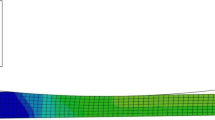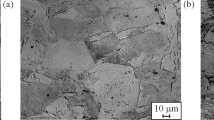Abstract
Since silicon steel is used in a laminated form, thickness profile in the width and the rolling directions should be accurately controlled. It is well known that the phenomenon of edge drop is one of very serious problems in cold rolling of silicon steel. In order to determine one of the better methods for reducing edge drop, a computer simulation was carried out in this study under various rolling conditions. It was found that the better way to reduce edge drop was to use a tapered work roll. A table was given for the optimal taper crown depending upon the diameter of work roll and the width of strip. The optimal condition was applied for actual cold rolling of silicon steel. As a result, edge drop was significantly alleviated.
Similar content being viewed by others
Abbreviations
- A ij :
-
Influence coefficient due to bending [Fig. 5]
- B :
-
Width of strip [Fig. 12]
- c :
-
Friction coefficient between WR (work roll) and BUR (back-up roll)
- D ij :
-
Flattening at center of the ith element when unit load is applied at center of the jth element [equation (13), Fig. 5]
- d(i) :
-
Flattening between WR and strip at the ith element [Eq.(12)]
- E :
-
Young's modulus of roll
- E w :
-
Young's modulus of WR [Eq. (13)]
- i, j :
-
Element index [Fig. 4]
- K s :
-
Spring constant between WR and BUR [equation (11)]
- L bw :
-
Relative rigid displacement between WR and BUR [Eq. (5)]
- ld :
-
Contact length between WR and strip [Eq. (13)]
- N :
-
Number of elements [Fig. 4]
- P i :
-
Rolling force between WR and strip at the ith element [Eq. (1), Fig. 4]
- Q i :
-
Contact pressure between WR and BUR at the ith element [Eq.(1), Fig. 4]
- P b :
-
Reaction force in the y-direction at BUR bearing [Eq. (3), Fig. 4]
- R b :
-
Reaction force in the z-direction at BUR bearing [Eq. (4), Fig. 4]
- R cb :
-
Crown of BUR [Eq. (11)]
- R cw :
-
Crown of WR [Eq.(11)]
- S i :
-
Contact pressure between WR and IMR of SRB (support roller bearing) at the ith element [equation (1), Fig. 4]
- Y by :
-
Deformation of BUR in the y-direction [Eq.(7)]
- Y bz :
-
Deformation of BUR in the z-direction [Eq.(8)]
- Y ws :
-
Dispacement at contact point between WR and strip
- Y wy :
-
Deformation of WR in the y-direction [Eq. (5)]
- Y wz :
-
Deformation of WR in the z-direction (Eq. (5)]
- Y bθ (i) :
-
Displacement of BUR in theθ i -direction [Eq. (10)]
- Y wθ (i) :
-
Displacement of WR in theθ i -direction [Eq. (9)]
- θ i :
-
The applied angle of contact pressureQ i [Eq. (1), Fig. 4]
- β i :
-
The applied angle of contact pressureS i [Eq. (1), Fig. 4]
- v :
-
Poisson's ratio [Eq. (11)]
- Δx :
-
Length increment in the x-direction
References
Bland, D.R. and Ford, H., 1948, “The calculation of Roll Force and Torque in Cold Strip Rolling with Tensions,” Proc. I. Mech. E., Vol. 158, p. 174.
The Iron and Steel Institute of Japan, 1983, “Theory and Practice of Plate Rolling,” pp.89–95.
The Iron and Steel Institute of Japan, 1983, “Theory and Practice of Sheet Rolling,” pp.305–308.
The Iron and Steel Institute of Japan, 1986, “A Handbook of Iron and Steel (Vol. 3, Rolling Foundation Steel Plate),” p.395.
Kitamura, K., 1977, “On the Control of Strip Profile in Hot Rolling Mill,” The Spring Conference of Tetsu-To-Hagane at Tokyo, Vol. 63, pp. A107-A110.
Kitamura, K., 1984, “Improvement of Edge Drop by Use of a Tapered Work Roll for Silicon Steel,” The Spring Conference of Tetsu-To-Hagane at Kawasaki, Vol. 70, pp.A60-A63.
Kono, T., Hase, N. and Nishino, T., 1980, “Development of Mathematical Model on Crown Control in Cold Strip Rolling,” Sumitomo Metal, Vol. 32, No. 3, pp. 93–103.
Mcdonald, I.R. and Spooner, P.D., 1987, “Improvement in Shape Performance Using CVC Rolls in 4 and 6 High Mills,” 4th International Steel Rolling Conference mat IRSID, E19.1–E19.8.
Monda, K., 1984, “Deformation Analysis Program of Multi-High Mill and Application to MKW MIII,” The Proceedings of the 35th Japanese Joint Conference for the Technology of Plasticity at Tokyo, pp.247–252.
Shiosaki, H., 1968, “An Analysis of Roll Bending for a Four-high Mill,” J. Japan Soc. Tech. Plasticity, Vol. 9, No. 88, pp.315–323.
Shohet, K.N. and Boyce, M.F., Nov. 1968, “Static Model Tests of Roll Bending Methods of Crown Control,” J. Iron and Steel Institute, Vol. 206, pp.1099–1102.
Shohet, K.N. and Townsend, N.A., 1971, “Roll Bending Method of Crown Control in Four High Mills,” J. Iron and Steel Institute, Vol. 190, p.769.
Tozawa, Y., 1970, “Analysis to Obtain the Pressure Distribution from the Contuour of Deformed Roll,” J. Jap. Soc. Tech. Plasticity, Vol. 11, No. 108, p. 29.
Tozawa, Y., 1975, “Roll Deformation and Effect of Roll Crown Affecting the Pressure Distribution,” J. Japan Soc. Tech. Plasticity, Vol. 16, No. 171, pp.345–351.
Walker, N.S. and Cook, J.W., 1958, “An Automatic Gage Control System for Tandem Cold Mills,” Iron and Steel Engineer, pp.124–130.
Yamamoto, 1982, “Shape Control of Plate at Z-high Mill,” J. Japan Soc. Tech. Plasticity, Vol. 23, No. 263, p. 1267.
Yasuda, K., Narita, K., Shida, S., Nishi, H. and Yoshimoto, K., 1987, “Rolling of Dead Flat Strip Using UC Mill with Small Diameter Work Rolls,” 4th International Steel Rolling Conference at IRSID, E22.1–E22.12.
Author information
Authors and Affiliations
Rights and permissions
About this article
Cite this article
Han, S.Y., Kim, J.T., Lee, Y.H. et al. Improvement on edge drop in cold rolling of silicon steel. KSME Journal 5, 108–114 (1991). https://doi.org/10.1007/BF02953609
Received:
Issue Date:
DOI: https://doi.org/10.1007/BF02953609




